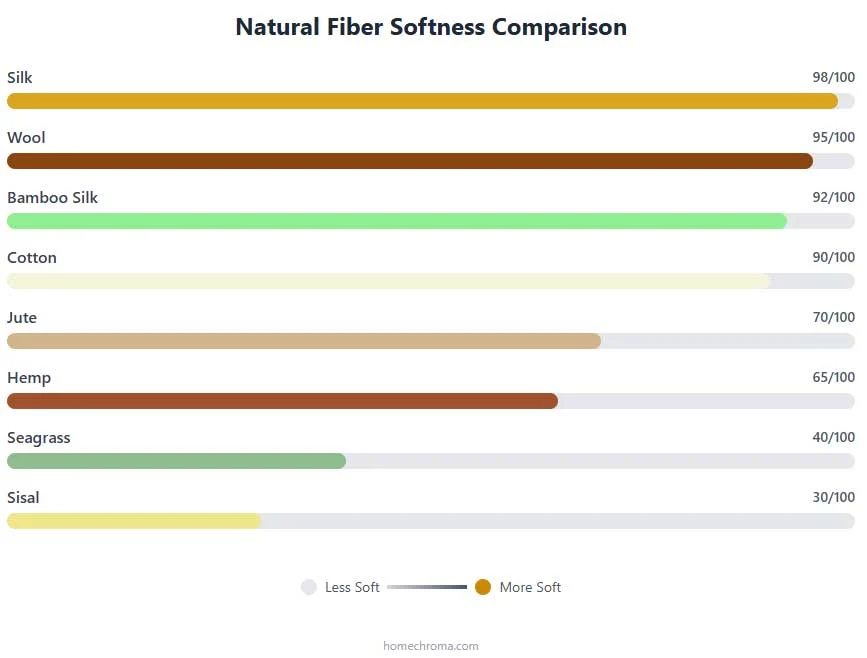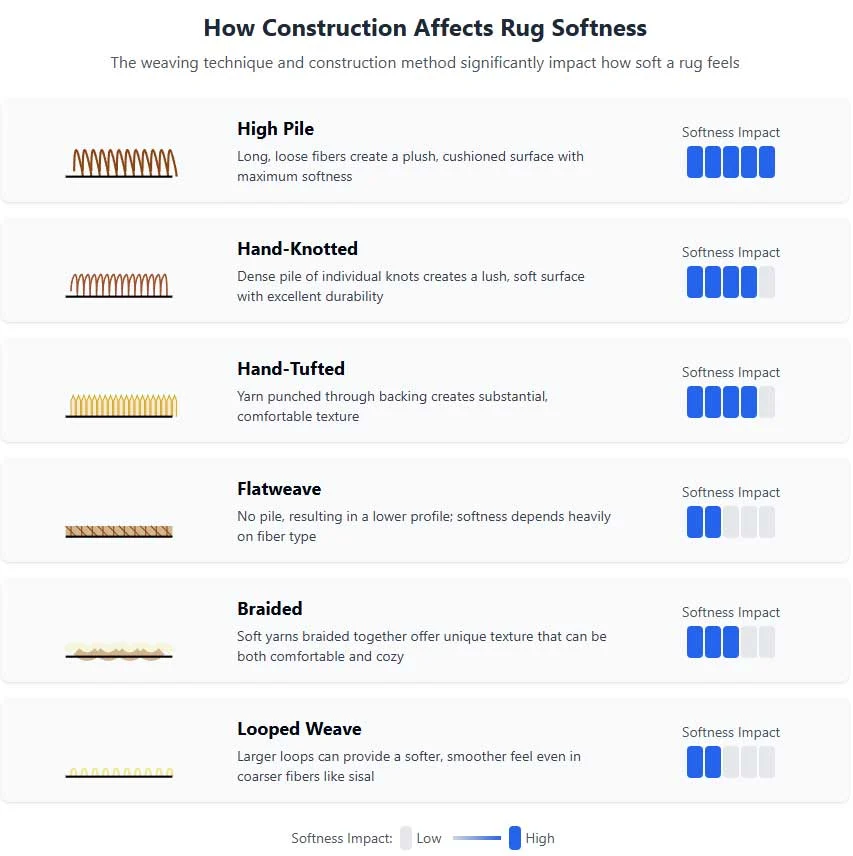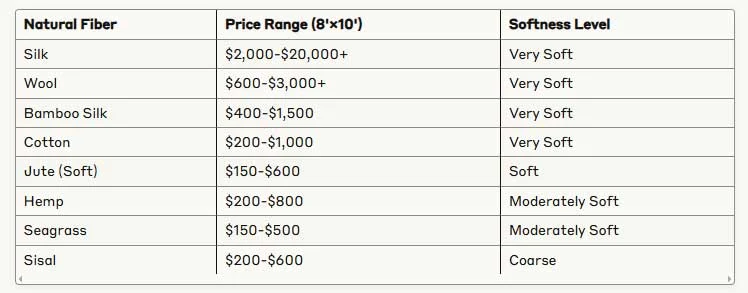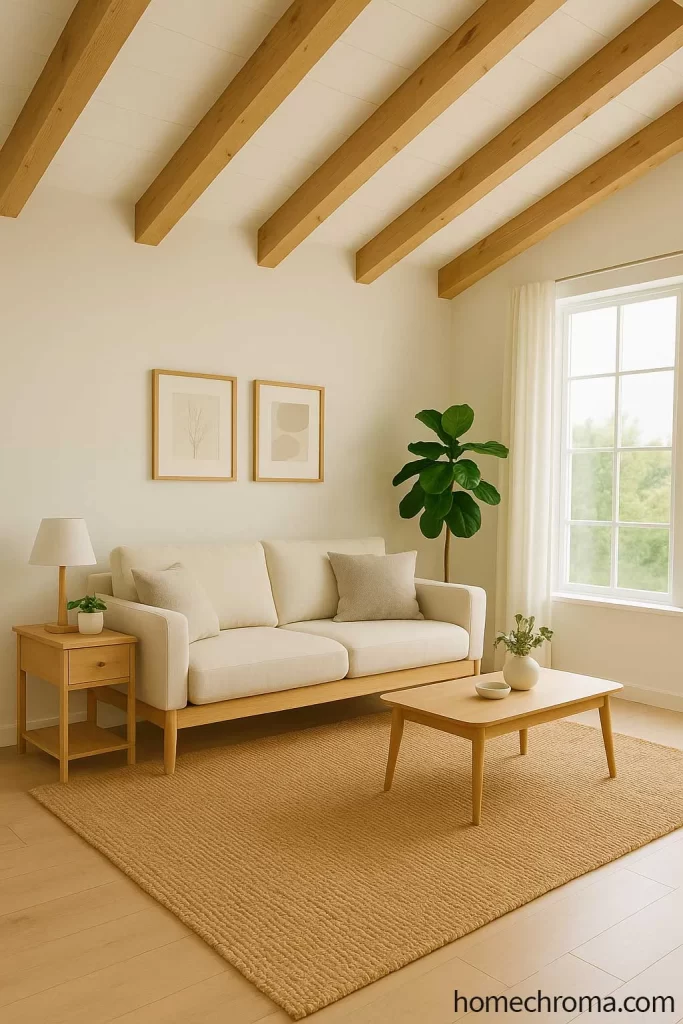
Natural fiber rugs bring warmth, texture, and sustainability to interior spaces. For many homeowners, softness is a critical factor when choosing rugs, particularly in areas where comfort is a priority. This guide examines the softest natural fiber options available, how construction affects softness, and where to find these cozy floor coverings.
Natural Fibers Ranked by Softness

Not all natural fibers offer the same underfoot experience. Here’s how they stack up from softest to most textured:
1. Wool
Wool consistently ranks as one of the softest natural fibers used in rug making. With a plush, springy feel, wool rugs provide exceptional comfort while also offering durability. The natural crimp in wool fibers creates a pillowy surface that many describe as luxurious. Walking barefoot on a high-quality wool rug feels like a gentle massage.
Best for: Living rooms, bedrooms, high-traffic areas where comfort is desired
2. Silk
Renowned for its unparalleled luster and smooth texture, silk represents the pinnacle of luxury in natural fiber rugs. The texture is smooth, velvety, and often described as “buttery soft.” With fibers thinner than wool, silk creates a uniquely soft surface underfoot. True silk rugs command premium prices but offer exceptional softness.
Best for: Formal living rooms, bedrooms, low-traffic showcase areas
3. Cotton
Cotton rugs provide a familiar softness comparable to a cotton t-shirt. Naturally soft and cozy, cotton makes an ideal choice for areas where you typically walk barefoot. The feel can be akin to being wrapped in a large, comfortable sweater. While not as durable as wool, cotton’s natural softness makes it perfect for casual spaces.
Best for: Bedrooms, nurseries, casual living areas
4. Bamboo Silk
As a sustainable alternative to traditional silk, bamboo silk offers impressive softness. Processed from bamboo plants, these fibers are engineered to replicate silk’s smooth feel. Bamboo silk rugs feature a subtle sheen and silky texture that adds elegance to any room.
Best for: Living rooms, bedrooms, medium-traffic areas
5. Jute
Jute often surprises consumers with its softness level. While not as plush as wool or cotton, many find jute fibers surprisingly comfortable underfoot, especially when produced in wet climates. The thick, bold weave contributes to a comfortable, almost cushiony feel. Some jute rugs even provide a gentle massage-like sensation to bare feet.
Best for: Bedrooms, living rooms, medium-traffic areas
6. Hemp
Hemp initially feels somewhat coarse but softens considerably with use. Comparable to jute in softness, hemp offers good durability and becomes increasingly comfortable over time as the fibers break in. Its sustainable nature makes it appealing for eco-conscious consumers.
Best for: Living areas, bedrooms, high-traffic areas
7. Seagrass
Seagrass provides a moderately soft texture, generally softer than sisal but not as plush as the options above. Its smooth, slightly glossy fibers create a unique underfoot feel that many find acceptable, particularly in areas where its water resistance is beneficial.
Best for: Kitchens, bathrooms, high-traffic areas
8. Sisal
Primarily known for durability rather than softness, sisal fibers are stiff and tough. The resulting rugs typically have a rougher texture underfoot. However, specific weaves (like chunkier patterns) can improve comfort.
Best for: High-traffic areas, entryways
Factors That Enhance Rug Softness
The inherent properties of natural fibers aren’t the only determinants of how soft a rug feels. Several construction factors significantly impact the tactile experience:
Pile Height
Higher pile rugs generally offer more cushioning and softness. Shag rugs with longer, looser fibers provide greater comfort underfoot. High-pile wool rugs are particularly noted for their exceptional softness.
Weaving Techniques
Different weaving methods produce varying textures:
- Hand-knotted rugs with fine wool or silk typically offer luxurious softness
- Hand-tufted rugs with thick, dense piles create substantial comfort
- Flatweave rugs have a lower profile but can still feel soft depending on the fiber
- Braided rugs, especially made from wool or cotton, provide unique textures
Fiber Blends
Combining softer fibers with more durable ones can enhance softness:
- Wool-jute blends offer more softness than pure jute
- Chenille-jute blends significantly improve comfort
- Cotton-wool combinations balance softness and durability
Construction Details

Even with traditionally rougher fibers like sisal, specific construction elements matter:
- Looser, chunkier weaves feel softer than tight weaves
- Wider, flatter weaves provide more comfortable surfaces
- Higher quality fibers within each category offer improved softness
Price Comparison of Soft Natural Fiber Rugs
The relationship between softness and price is generally direct—softer natural fibers often command higher prices. Here’s a general price comparison for standard-sized rugs (8’×10′):

Factors affecting price include:
- Quality of fibers
- Construction method (hand-knotted vs. machine-made)
- Brand reputation
- Design complexity
- Size
Recommended Retailers for Soft Natural Fiber Rugs
Online Retailers
- Sisal Rugs Direct: Features a “Softest Rugs Ranked” section highlighting wool options
- Rugs.com: Offers soft natural rugs including jute, wool, and cotton
- Fab Habitat: Specializes in eco-friendly rugs including soft jute options
- Natural Rug Co: Provides sustainable natural fiber rugs with customer reviews highlighting softness
- Annie Selke: Known for surprisingly soft natural fiber options
- Ben Soleimani: Offers what many consider the softest jute rugs available
- Revival Rugs: Highlighted by experts for quality jute and wool rugs
Home Goods Stores
- Pottery Barn: Offers popular chunky wool/jute blends that balance texture and softness
- West Elm: Known for soft jute chenille herringbone rugs
- World Market: Features reasonably priced jute options
- Target: Sells natural fiber rugs at accessible price points
- Crate & Barrel: Recognized for sisal and other natural fiber rug offerings
- Serena & Lily: Noted for stylish jute and sisal rugs
Customer Insights on Soft Natural Fiber Rugs
Real customer experiences provide valuable perspectives on softness:
- A Natural Rug Co customer described a wool rug as having a “soft and luxurious underfoot” feel, confirming wool’s reputation for softness.
- A RugsUSA customer found their premium jute rug “very soft,” contradicting assumptions that all jute is coarse.
- Reviews of the Ben Soleimani Braided Jute rug consistently mention it’s “by far the softest of any jute rug” they’ve felt—”comfortable enough to sit on.”
- Surprisingly, Annie Selke’s Wave Woven Sisal rug has been described as having “a softness that is truly shocking” despite being made from sisal, traditionally considered rough.
- Customers frequently note that chenille-jute blends offer significantly improved softness compared to standard jute rugs.
Choosing the Right Soft Natural Fiber Rug by Room
Bedrooms

Prioritize maximum softness:
- High-pile wool rugs
- Cotton rugs (especially braided or high-pile)
- Silk or bamboo silk for luxury
- Softer jute options (chenille blends)
Living Rooms

Balance comfort and durability:
- Wool rugs (medium pile)
- Wool-jute blends
- Quality jute rugs (braided construction)
- Bamboo silk for a luxurious yet functional option
High-Traffic Areas

Focus on durability without sacrificing comfort:
- Low-pile wool rugs
- Hemp rugs (will soften over time)
- Higher-quality sisal with softer weaves
- Specialized seagrass constructions
Conclusion
When searching for the softest natural fiber rugs, wool and silk remain the premium choices for ultimate comfort, with cotton offering excellent softness at more accessible price points. For those seeking alternatives, specially constructed jute rugs and bamboo silk provide surprisingly pleasant tactile experiences.
Construction matters tremendously—high-pile, hand-knotted, or hand-tufted rugs generally offer superior softness regardless of fiber type. Specific brands and collections known for exceptional softness include Ben Soleimani’s jute line, West Elm’s chenille constructions, and Annie Selke’s specially woven sisal.
The ideal choice balances your desired level of softness with practical considerations like budget, durability needs, and the specific room’s usage patterns. By understanding natural fibers’ inherent properties and how construction techniques enhance comfort, you can confidently select a rug that feels as good as it looks. Additionally, Checkout my 7 pet friendly rugs for living room if you have pets.
Dora Decora is a biophilic interior design specialist and passionate blogger. With a deep commitment to integrating nature into living spaces, Dora specializes in creating environments that foster human-nature connections through thoughtful design elements. Her approach emphasizes sustainable materials, natural lighting, and organic patterns that enhance wellbeing and reduce environmental impact.
This post (https://homechroma.com/the-softest-natural-fiber-rugs/) was originally published by Dora Decora on Home Chroma. As an Amazon Associates partner, qualifying purchases are compensated.


